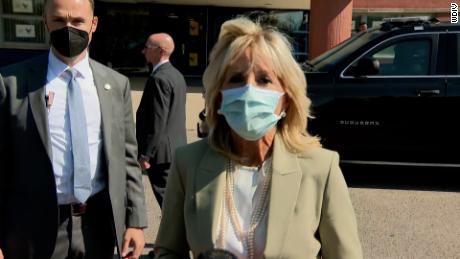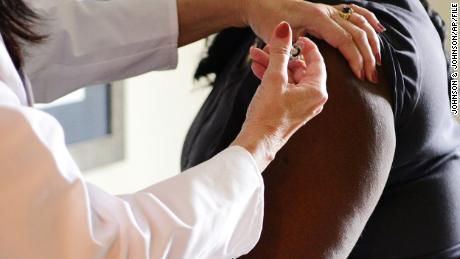(CNN)Daily coronavirus case numbers in the US are at levels not seen since the summer, and more than a dozen states set record highs for Covid-19 hospitalizations in the past week -- yet more evidence, experts say, of a difficult fall and winter ahead.
The country's seven-day average of new daily cases was above 58,300 as of Monday -- a level not seen since the first week of August, and climbing closer to the summer's peak of 67,200 on July 22.
Average daily new cases have soared 70% since September 12, when the country was at a two-month low of about 34,300.
As cold weather is likely to drive more gatherings indoors, the case level appears too high to avoid dangerous levels of infections and hospitalizations in the coming weeks, experts have said.
"(With) the fact that we're only going to see more transmission occur with indoor air, people inside, this is going to be a rough fall," Michael Osterholm, the director of the Center for Infectious Disease Research and Policy at the University of Minnesota, told CNN on Tuesday.
Case rates and hospitalizations are rising especially in the Midwest, Great Plains and parts of the West.
Fourteen states reported their peak Covid-19 hospitalizations in the past week: Alaska, Arkansas, Iowa, Kansas, Kentucky, Montana, Missouri, Nebraska, North Dakota, Oklahoma, South Dakota, Utah, West Virginia and Wisconsin, according to the Covid Tracking Project.
The virus's prevalence is bad enough that the director for the National Institutes of Health says his family won't gather for Thanksgiving this year.
"It is just not safe to take that kind of chance with people coming from different parts of the country of uncertain status," Dr. Francis Collins told National Public Radio's "Morning Edition" on Tuesday. "The problem with this disease is it is so easy for people to be infected and not know it, and then spread it to the ones next to them without realizing it."
"All of this, I'm afraid, happens because we have not succeeded in this country in introducing really effective public health measures," Collins said.
"Simple things that we all could be doing: Wear your mask, keep that 6-foot distance, and don't congregate indoors, whatever you do, and wash your hands. And yet people are tired of it and yet the virus is not tired of us," Collins said.
The country has now topped 220,000 Covid-19 deaths, a number some experts worry may also begin to climb faster.
"The numbers are moving in the wrong direction," Dr. Tom Inglesby, the director of the Johns Hopkins Center for Health Security, told CNN Monday night. "We see that happening as the weather gets colder, and it's likely ... to get worse."
US has had nearly 300,000 excess deaths amid the pandemic so far, CDC study suggests
The United States has seen nearly 300,000 excess deaths so far since late January -- about two-thirds of which were attributed to Covid-19, according to a report published Tuesday by the US Centers for Disease Control and Prevention.
The groups with the biggest jump in excess deaths, percentage-wise, have been adults ages 25 to 44, and Hispanic people, the report says.
The report included mortality data from January 26 through October 3, to help researchers measure how many more people died this year during the coronavirus pandemic than otherwise would have been expected.
"An estimated 299,028 more persons than expected have died since January 26, 2020; approximately two-thirds of these deaths were attributed to Covid-19," CDC researchers wrote in the report.
"Although more excess deaths have occurred among older age groups, relative to past years, adults aged 25-44 years have experienced the largest average percentage increase in the number of deaths from all causes from late January through October 3," the researchers wrote.
"Among racial and ethnic groups, the smallest average percentage increase in numbers of deaths compared with previous years occurred among White persons (11.9%) and the largest for Hispanic persons (53.6%)."
The report has some limitations, including that mortality data can lag, and estimates of how many deaths would otherwise be expected are based on models.
Look out for your mental health, doctor says
As the pandemic gets worse, Americans need to look out for their mental health, Dr. Peter Hotez, dean of the National School of Tropical Medicine at Baylor College of Medicine, said.
He advised people to think about whom they are going to social distance with during the coming surge and having mental health resources ready.
"Try not to be totally alone during this period, and look out for your mental health, because the normal response to this is people are going to get sad and upset, and maybe even depressed, so have access to mental health counseling," Hotez said.
The sheer number of Covid-19 related deaths is already having a huge impact, another expert said.
Americans are experiencing "an epidemic of pathological grief, which is a downstream consequence of the pandemic," said Dr. Charles Marmar, chair of the department of psychiatry at the New York University Grossman School of Medicine.
For every death, there are nine people who are profoundly impacted, in terms of grief and risk for psychiatric complications. That's about 3 to 4 million Americans, given recent death rates, Marmar told JAMA editor-in-chief Dr. Howard Bauchner.
Marmar said that roughly one in 10 of those people will experience something called pathological grief, which is characterized by "persistent, unremitting painful experiences."
He said these experiences include "constant yearning, searching and pining for the person who has died," increased depression and substance use, and suicidal ideation.
He added that even those who have not lost a loved one during the pandemic are impacted by a second kind of psychological epidemic, one of anxiety, depression and uncertainty.
Roughly 30-40% of the population is burdened with stress, anxiety and depression, he said.
Vaccines likely won't be authorized before late November, Collins says
The United States likely will not have a Covid-19 vaccine authorized by the US Food and Drug Administration before late November, Collins told NPR on Tuesday.
That more or less goes along with with other officials' recent statements about the availability of any vaccine, as several candidates are in late-stage trials around the world.
"I would think it's very unlikely -- given the timetables and the standards that have to be followed -- that you will hear about an emergency use authorization before late November at the earliest," Collins told NPR.
"These will be vaccines that are tested with the most rigorous standards for safety and efficacy," Collins said. "If we get to the point by sometime, maybe the end of this year, where one or more of those is judged to be safe and effective, it will be because it's safe and effective."
US officials have said that if and when an emergency authorization is given for a vaccine, vulnerable populations, such as those in long-term care facilities, will be given first access.
Health and Human Services Secretary Alex Azar said last week he believes there will be enough vaccines by the end of December to vaccinate the most vulnerable populations in the United States. By the end of January, he said, there will be enough to vaccinate all seniors and health care workers and first responders.
"By the end of March, early April, we believe we will have enough vaccine produced to vaccinate anybody in the United States who wanted to get vaccinated," Azar said.
Once a vaccine is approved in the US, CVS and Walgreens pharmacies have been designated to help distribute free vaccines to long-term care facilities, federal officials have said.
But for the general population, "we're not going to have vaccines in any meaningful way well into next year," Osterholm said Tuesday.




























